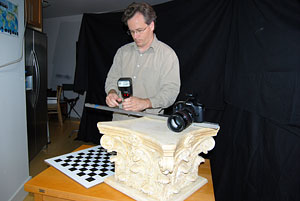On this week’s TV episode of QUEST, we go behind the scenes of Tales of Maya Skies, the new film produced by Oakland’s Chabot Space and Science Center. The half-hour film about Maya astronomy opens at the center’s planetarium on November 21.
The film is groundbreaking for a couple of reasons. It’s the first time the Chabot center is using state-of-the art laser scanning technology to create one of its films. For Tales of Maya Skies, a team of 25 people spent seven weeks scanning the ruins of the ancient city of Chichén Itzá, in Mexico’s Yucatán Peninsula. This technology is widely used by Hollywood productions because of the flexibility it gives a creative team. Once they’ve scanned a particular site, they can play with any one of its variables: they can create the illusion that the camera is moving in crazy ways; they can manipulate the light conditions, and they can change the look of the location in any way they want.
The creative team behind Tales of Maya Skies, made up of, among others, Emeryville nonprofit Insight, the San Francisco animation companies Digitrove and Palma VFX, the ARTS Lab at the University of New Mexico, producer Konda Mason and director Jin An Wong, are taking advantage of all the possibilities that the scanning of Chichén Itzá provides. The audience will be immersed in full-color animations that go beyond showing the ruins of Chichén Itzá as they exist today. Instead, through laborious historical research, the creative team has reconstructed what the monumental city must have looked like at its peak 1,200 years ago, with temples painted in bright reds, greens, blues and yellows, and incense burning and flags waving atop them.
By using the 3-D digital images created through laser scanners as the raw material for the animations in Tales of Maya Skies, the film is also breaking ground in more indirect, but perhaps even more important, ways. Insight, the Emeryville nonprofit that oversaw the scanning at Chichén Itzá, as well as the Orinda-based CyArk, another nonprofit that worked on the project, are engaged in scanning irreplaceable sites around the world, documenting them for the benefit of the archaeologists charged with preserving them, as well as for generations to come, which might lose the real thing to natural disasters, war, or the passage of time. CyArk’s co-founder, Ben Kacyra, has set out to use laser scanners to document 500 sites in five years.

But laser scanners, for all the wonderful detail, speed and flexibility they offer, are expensive. They can cost anywhere from $10,000 to $150,000. That’s why Kevin Cain, Insight’s director, has been testing an alternative system that can accomplish the same thing at a fraction of the cost. All the gear he needs is a digital camera, a flash and software, at a total cost of under $2,000. Here’s how it works. For every 32-square-foot swatch of an object, Cain takes 10 still photos with his camera and flash. Then he uses the photos to reconstruct the object based on the brightness of each individual point on its surface. The system is based on a principle of physics discovered in the 18th century. The high quality of today’s cheap digital cameras is what makes it possible to apply this principle to create an inexpensive image-capturing system.